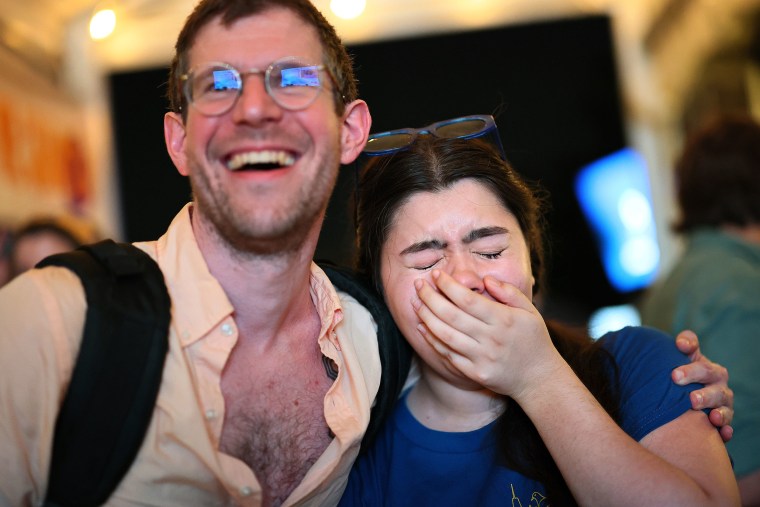Zohran Mamdani didn’t just score more first-place votes Tuesday night in New York City’s Democratic mayoral primary — he also prompted his closest rival, former Gov. Andrew Cuomo, to concede before the night was over, making the city’s ranked choice tabulation feel like a formality.
While Mamdani’s supporters claim the outcome was no surprise, Cuomo had widely been considered a probable first-round winner until the election, with Mamdani and allied candidates organizing to deny him a ranked-choice majority via cross-endorsements.
However, several key factors ultimately swung the race in Mamdani’s favor.
Defying polling expectations
Two of the most recent pre-election, nonpartisan polls had Cuomo leading in the first round. Emerson College showed Cuomo ahead by 3 points in the first round, and before that Marist University showed Cuomo leading by 12 points in the first-choice tally. Mamdani finished the unofficial tally last night 7 points ahead.
But polls tend to be a lagging indicator based on time in the field and release dates, especially in primaries. You could see momentum for Mamdani between those two polls, and it’s possible his surge really did come with the broader electorate in the final days of the campaign. It’s also possible a municipal primary election is just a tough type of race to get accurate polling results.
The ‘Mamdani Mirage’ mirage
A recent trend in general elections has been red and blue “mirages” — patterns in election returns that have developed around the way people choose to vote.
Mail ballots in recent elections have become a very Democratic-friendly group. Election Day ballots, on the flip side, are typically more Republican-friendly votes. And when one set of ballots is reported first without the other, it can lead to a false sense of the race — a “mirage” for observers looking at the vote count.

There was reason to believe a similar pattern might emerge in the primary elections. In the 2021 mayoral primary, Eric Adams won the mail vote by a point (23% of the first-choice votes, to Kathryn Garcia’s 22% and Maya Wiley’s 15%). But when it came to the Election Day vote, Adams was beating his nearest rival, Wiley, by 10 points (32%-22%).
The first report from New York City last night showed Mamdani winning a combination of mail and early votes by 9 points (43%-34%) over Cuomo. But an anticipated significant divergence between those figures and the Election Day vote never materialized. An estimate at the end of the night of votes cast Election Day had Mamdani winning 44%-38% over Cuomo among that group.
Democrats grow in Brooklyn
New York City’s most populous borough is also home to the most registered Democrats — and Mamdani was able to make the most of them.
While Brooklyn has seen some growth in its Democratic population since 2021, Mamdani’s significant achievement this year was turning out its voters in droves.
Brooklyn’s share of the electorate grew compared to the 2021 Democratic primary, and Mamdani posted better numbers than Adams — who was Brooklyn borough president at the time of the 2021 primary.
A unique coalition
Mamdani, 33, clearly appealed to younger voters. His near-ubiquity on social media, in both earned and unearned media, undoubtedly bolstered his appeal through Election Day.
An analysis by Gothamist found that nearly half of early voters were younger than 45, meaning turnout in 2025 was likely younger overall than the 2021 turnout.
But another key commonality among Mamdani’s supporters may have been the typical signs of gentrification: mobility and an influx of new residents. This includes young individuals moving to the city for the first time, young professionals seeking more affordable rents and families relocating for more space.

StreetEasy, Zillow’s New York City brand, annually puts out a list of the city’s “top neighborhoods to watch.” As it describes the list, these are the neighborhoods that have experienced the largest surge in searches among buyers and renters in New York City.
These neighborhoods, popular with new arrivals, are the front line of gentrification, representing the most burgeoning areas for the modern city dweller.
In these Top 10 neighborhoods, Mamdani decisively beat Cuomo 57%-21% in the first-choice tally.
In all other neighborhoods not on this list, Mamdani still led the former governor, but by a narrower margin of 42%-38%.
Mamdani’s best performance in Queens was the neighborhood of Ridgewood, which he carried 80%-11% over Cuomo, who is 67 years old. The neighborhood is 40% white, 45% Latino and 9% Asian. It’s a diverse population — and also No. 1 in terms of where new residents are flocking and looking to flock to in 2025, according to StreetEasy.
Mamdani’s best performance in Brooklyn, meanwhile, was in a neighborhood just to the south of Ridgewood: Bushwick. It’s a majority-Latino neighborhood, per census data. But it has also been a place where young people have clustered in recent years. The median age here is 31.0, census data shows, compared to a 36.8 average for the city as a whole.
Overall, Mamdani showed strength in places with the highest concentration of young voters — outside of the Orthodox Jewish population centers — in neighborhoods across the city. Cuomo, either by name, reputation or his platform, performed best in older neighborhoods.
Mamdani and Cuomo were also at odds in neighborhoods at opposite ends of the educational spectrum. Mamdani performed best in neighborhoods with the highest levels of college degree attainment, while Cuomo showed better strength with the crowd without a college degree.
And candidate preference by race and ethnicity was somewhat mixed around the city. But Mamdani overall performed better with nonwhite voters than expected, gobbling up votes that Cuomo was unable to capture.
